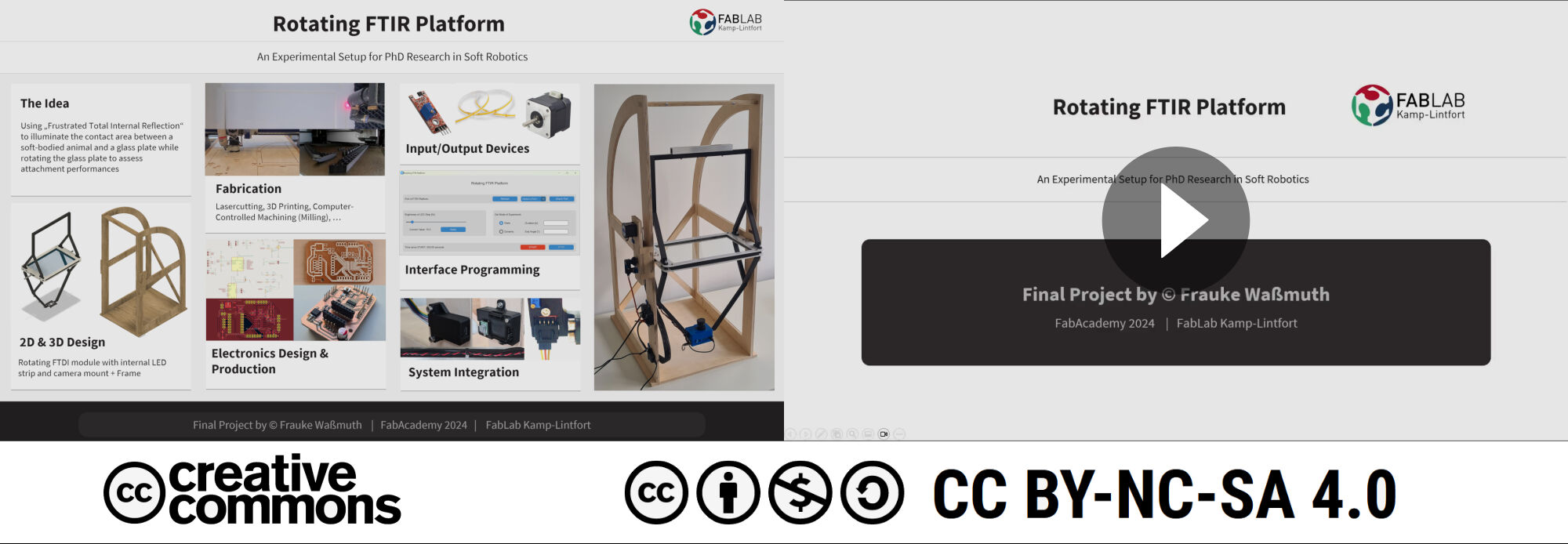
18 - Invention, Intellectual Property and Income
This week was the last week of FabAcademy. As most of the students are working towards the final presentations next week and the week after, the content this week was reduced to a minimum. Parts of the assignment even prepared the students for the presentations as we had to upload the slide and video that will be shown when presenting. There was one other assignment in addition to these. In total, we had the following tasks:
- Develop a plan for dissemination of your final project
- Prepare drafts of your
- Summary slide (name: presentation.png, resolution: 1920 px x 1080 px)
- Video clip (name: presentation.mp4, resolution 1080p HTML5, length: about one minute, size: 10 MB)
- And put them in your root directory (public/)
In addition to that, I am presenting some future plans for my final project.
Dissemination Plan
Before doing FabAcademy I did not know what this was. However, within the lecture it was explained to us as a plan on how the students would like to share the content and data on our website with others, including the license, e.g. copyrights.
While doing FabAcademy, I got to know that the people involved in it usually freely share information to let other people make similarly awesome things, to let them learn and benefit from their developments. Instead of denying access, they are open and transparent. Similarly in my job as a researcher, I am always happy if I find research papers that are not behind a paywall but freely accessible.
Inspired by that, I would also like my project to be accessible for everybody. Nevertheless, I would like to get some credit for my invention, similar to citing the research paper when using their information. A common way of doing this is by using a Creative Commons license. On their website, there is a page where their different licenses are displayed and explained.
There are several option for a license. In addition to the "standard" one where everybody can use the data but must give credit to the creator, i.e. the CC BY, there are other extensions to it.
- SA: Adaptations must be shared under the same terms.
- ND: No derivatives or adaptations of the work are permitted.
- NC: Only noncommercial uses of the work are permitted.
After reading through it and assessing their value for me, I decided to choose the CC BY-NC-SA license as this also allows for adaption, contributions and improvements of others.
Rotating FTIR Platform
by
Frauke Waßmuth is licensed under
CC BY-NC-SA 4.0
Future Plans
After FabAcademy, I would be really happy to properly use the experimental setup that I developed as my final project. Especially generating data that can be published is a central goal of mine. In case that happens, I aiming to link my FabAcademy website somewhere in the paper to let people know such a setup can easily and cost efficiently made.
I really loved making such an experimental setup that can be of use for research. In future, I would like to center the design of such a project, in case I will develop another setup, around usability, ease of assembly and a cleaner design. This was my first ever project like this and I had some difficulties assembling everything, especially with the ball bearings and the shaft which needed a bearing press to be assembled. Furthermore, even though it works flawlessly, I would have liked a cleaner design. The assignment on system integration did already help a lot but afterwards it still looked messy. This however might also be due to the many cables that are needed to power the Raspberry Pi camera, the motor, the LED strip and the main board with its break-out boards like the Hall sensor and the FTDI module. Instead, a single power source would allow for an improved usability.
